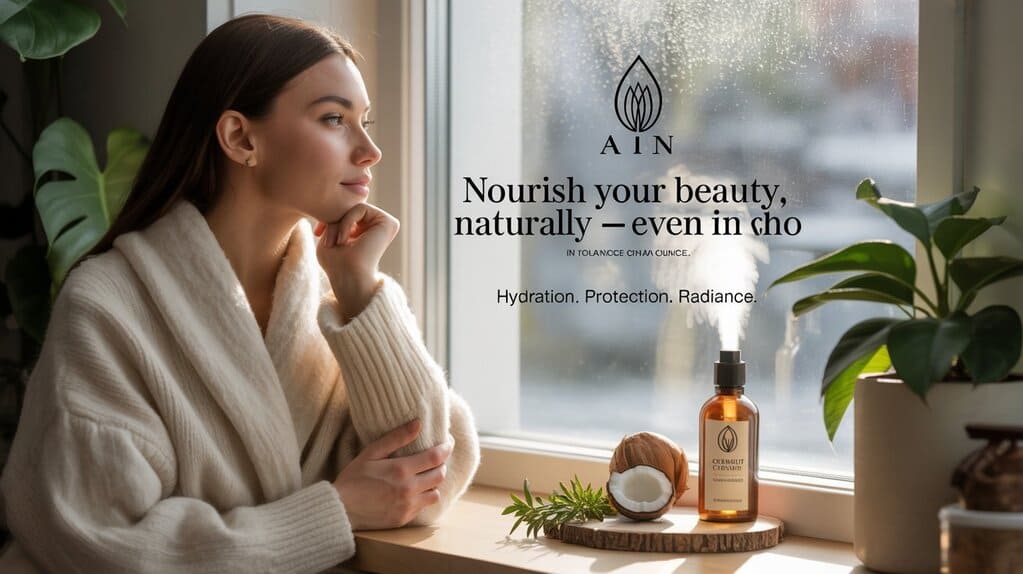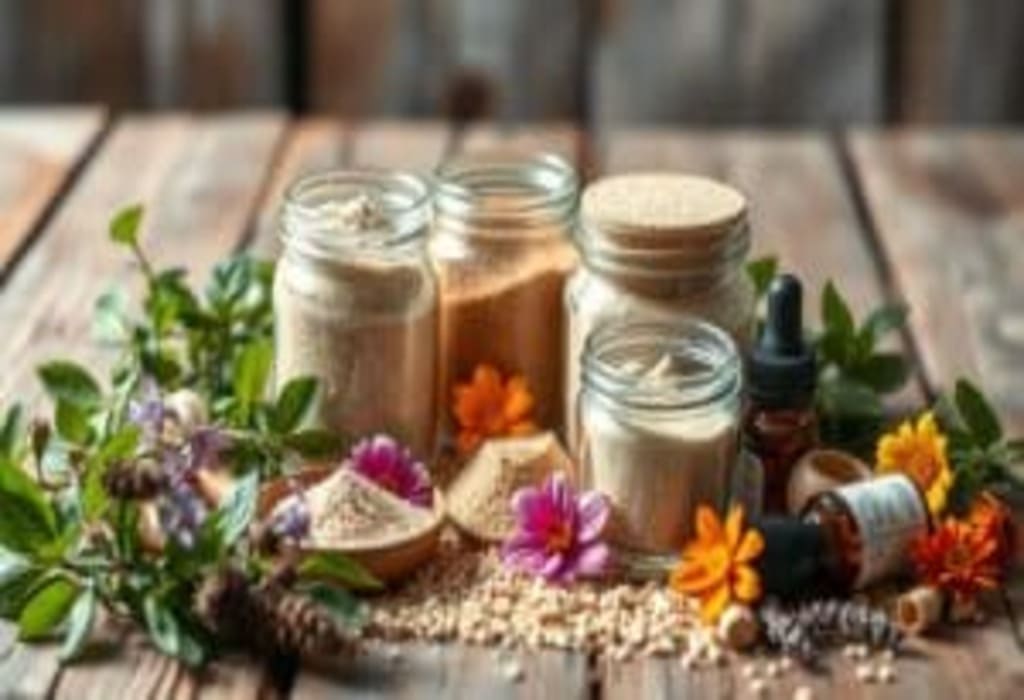
Introduction
If you’re looking for natural skincare that’s affordable, versatile, and rooted in tradition and science, natural and healthy powders deserve a front-row seat in your routine. From colloidal oatmeal that soothes irritation to green tea (matcha) powder rich in antioxidants, and from turmeric to rice bran and kaolin clay, these fine powders can support skin barrier health, help balance oil and acne, and even contribute to overall wellness when used appropriately. In this in-depth guide, we’ll summarize what they are, how they work, what the research says (including recent medical studies from Asia, America, and Europe), how to use them safely, and where they fit in a summer-to-winter routine.
SEO focus keywords used throughout: natural powders, skin health, overall health, colloidal oatmeal, kaolin clay, turmeric powder, matcha green tea, rice bran powder, vitamin C powder, collagen peptides, acne, eczema, hyperpigmentation, skin barrier, photoprotection, antioxidants, DIY skincare, clean beauty.
Key Takeaways (Skim This First)
- Colloidal oatmeal is one of the most evidence-based natural powders for soothing eczema and irritated skin by supporting the skin barrier.
- Green tea (EGCG) powders/extracts show human data for photoprotection and reducing UV-induced changes in skin, adding antioxidant defense alongside sunscreen.
- Turmeric/curcumin has growing dermatologic evidence for inflammation, acne adjuncts, and pigmentation modulation, though formulation and stability matter. Wiley Online LibraryLippincott
- Rice bran/oryzanol delivers antioxidants (e.g., ferulic acid) with emerging support for photoprotection and barrier support.
- Kaolin clay is a gentle mineral powder that absorbs excess sebum and is widely used in masks and cleansers. PMC
- Vitamin C powder (ascorbic acid) in water-based mixes can brighten and support collagen—but pH and stability are crucial for results.
- For overall health benefits that show up on your skin, oral collagen peptide powders have RCT-level evidence for modest improvements in elasticity and wrinkles.
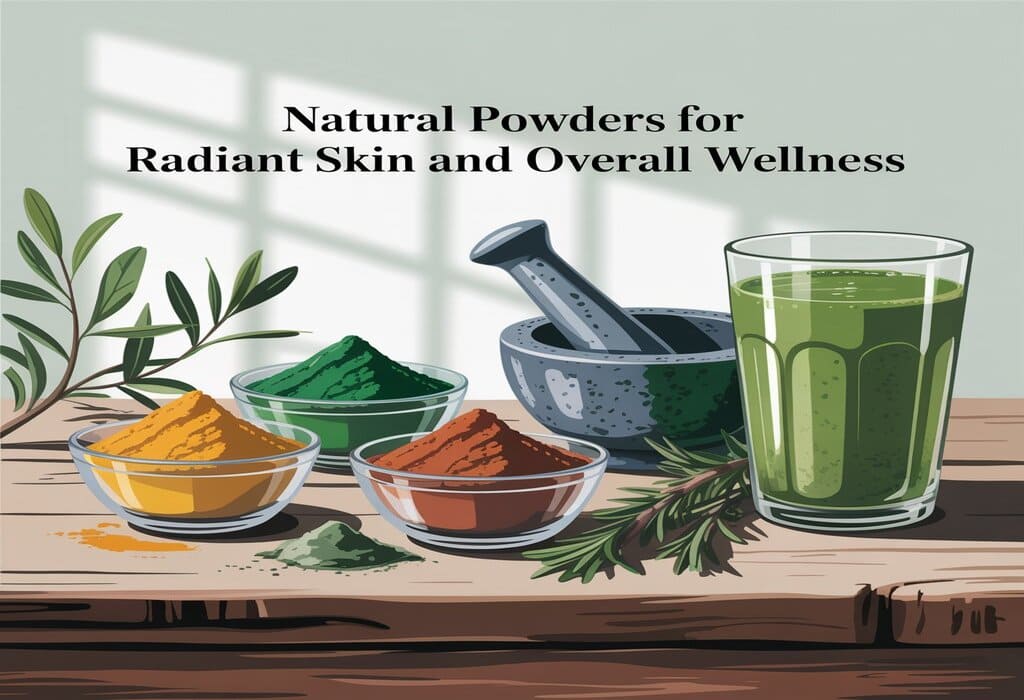
What Are “Natural Powders”? (Fast Definitions)
- Colloidal oatmeal: finely ground, water-dispersible oat powder rich in β-glucans and avenanthramides used to soothe inflamed skin.
- Kaolin: a soft white clay (primarily kaolinite) used in cosmetics for mild cleansing and oil absorption.
- Rice bran powder: milled outer layer of rice rich in γ-oryzanol, ferulic acid, and lipids.
- Vitamin C (ascorbic acid) powder: crystalline, water-soluble antioxidant that can be mixed fresh for topical use.
- Matcha/green tea powder: powdered Camellia sinensis leaves high in catechins like EGCG.
Evidence-Backed Powders: What Science Says
1) Colloidal Oatmeal: Barrier-First Care
Why it works: Oat β-glucans and avenanthramides calm cytokine activity and improve moisturization. Clinical research highlights benefits in atopic dermatitis and irritant dermatitis, supporting improvements in eczema signs and symptoms. Key experts in dermatology across the U.S. and Europe have published on its mechanism and clinical effects.
How to use:
- Mix 1–2 tsp powder in cool water to create a milky soak; apply with cotton or add to a bath for 10–15 minutes.
- As a mask: blend with water or a fragrance-free gel base; rinse after 10 minutes.
- Frequency: 2–4× weekly during flare season; daily as a spot-soother.
Good for: Eczema, sensitive skin, post-procedure calming.
2) Green Tea (Matcha) Powder & Extracts: Antioxidant Photoprotection
Human studies (Asia, Europe, U.S.) report that green tea catechins—especially EGCG—can reduce UV-induced erythema and matrix metalloproteinase activity (one contributor to photoaging). While not a substitute for SPF, green tea provides a secondary shield.
How to use:
- Topical: 1–3% green tea extract serum/toner; DIY masks with matcha are popular but aim for standardized extracts for consistency.
- Oral: brewed green tea as a lifestyle habit (watch caffeine if sensitive).
Good for: Photodamage, dullness, oil control (mild).
3) Turmeric (Curcuma longa) Powder: Inflammation & Tone
A broad systematic review found that topical and oral curcumin can modulate skin inflammation; newer dermatology reviews discuss pathways (e.g., tyrosinase inhibition, MAPK signaling) relevant to dyschromia. Early RCTs and pilot trials explore acne and melasma adjuncts; stability and delivery systems (liposomes, nanoparticles) are active areas of research across Asia and Europe. Wiley Online LibraryLippincott
How to use:
- Spot masks: mix a pinch of turmeric with yogurt or honey; avoid staining by keeping concentration low and rinse thoroughly.
- Look for encapsulated curcumin in serums to reduce staining and improve penetration.
Good for: Redness-prone skin, post-blemish marks, overall radiance.

4) Rice Bran Powder: Gentle Brightening & Barrier Support
Rice bran is rich in γ-oryzanol and ferulic acid, providing antioxidant defense. Reviews and laboratory data suggest roles in UV defense and barrier lipids; Japan and other Asian countries have a long tradition of using rice-derived powders in skincare.
How to use:
- As a polishing cleanser: mix 1 tsp with water to a thin paste; massage briefly and rinse.
- As an additive: blend a small amount into a gentle gel mask.
Good for: Uneven tone, rough texture, dullness.
5) Kaolin Clay: Oil-Balancing without Over-Stripping
Kaolin is a cosmetic mainstay for absorbing excess oil while staying gentler than harsher clays. It’s broadly tolerated, making it helpful for combination and oily skin in humid climates.
How to use:
- Mask: mix with water or rose water; apply thinly and remove before fully dry to avoid dehydration.
- Cleanser boost: sprinkle a small amount into your cream cleanser for a “detox” feel.
Good for: Shine, congestion, maskne support.
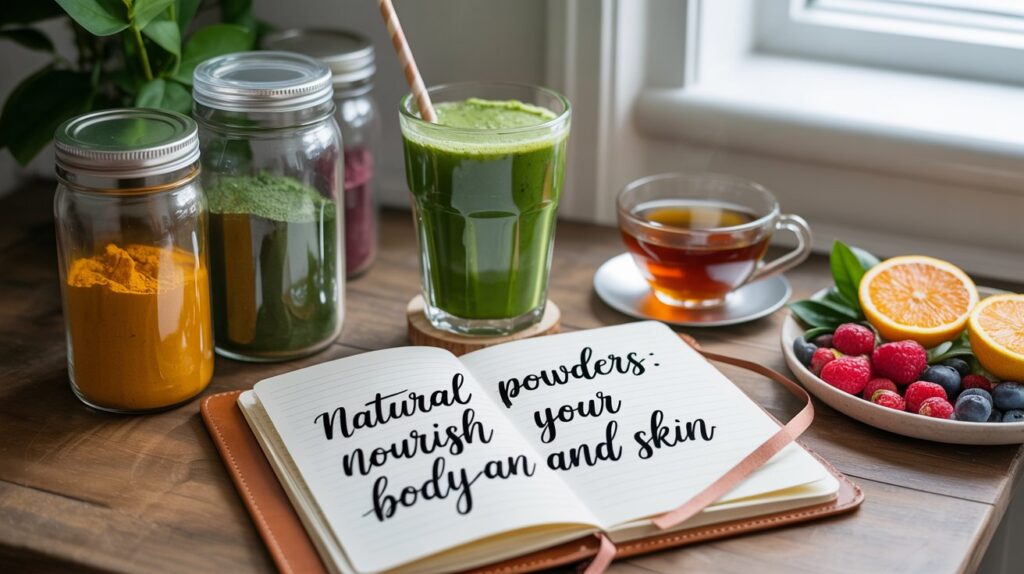
6) Vitamin C (Ascorbic Acid) Powder: Brightening & Collagen Support
Vitamin C is a topically proven antioxidant for brightening, supporting collagen synthesis, and reducing hyperpigmentation—but it’s famously unstable. Freshly mixed ascorbic acid powder in a low-pH solution (≈3.0) can improve stability and efficacy. Reviews note benefits for photoaging and uneven tone; combine with SPF for daytime.
How to use:
- DIY booster: dissolve a small pinch (~5–10% w/v) in a few drops of distilled water or a compatible serum right before application.
- If irritation occurs, switch to gentler derivatives (e.g., magnesium ascorbyl phosphate).
Good for: Dark spots, dullness, fine lines.
7) Oral Collagen Peptide Powders: Skin from the Inside
A 2021 systematic review and meta-analysis of randomized controlled trials found that oral collagen peptides (typically 2.5–10 g/day for 8–12 weeks) produced modest improvements in skin elasticity and hydration in adults. These trials were conducted across Europe, Asia, and the U.S., reflecting a global research base.
How to use:
- Mix daily with water, smoothies, or coffee.
- Expect subtle results after 8–12 weeks; continue a broad skincare routine for best outcomes.
Good for: Intrinsic aging, dryness, fine lines.
Quick-Compare Table: Natural & Healthy Powders
| Powder (Form) | Main Actives | Primary Benefits | Best For | Typical Topical Use | Evidence Snapshot |
|---|---|---|---|---|---|
| Colloidal oatmeal | β-glucans, avenanthramides | Soothing, barrier support | Eczema, sensitivity | Soaks, masks 2–4×/wk | Clinical improvements in dermatitis symptoms. |
| Green tea (matcha/extract) | EGCG, catechins | Antioxidant, photoprotection adjunct | Dullness, photoaging | 1–3% extract serum; tea habit | Human studies show reduced UV-induced changes. |
| Turmeric (curcumin) | Curcuminoids | Anti-inflammatory, tone evening | Redness, PIH | Low-dose masks; encapsulated serums | Systematic review + emerging RCTs. Wiley Online LibraryLippincott |
| Rice bran powder | γ-oryzanol, ferulic acid | Gentle brightening, antioxidant | Uneven tone, roughness | Polish cleanser 2–3×/wk | Traditional use + modern antioxidant data. |
| Kaolin clay | Kaolinite | Sebum control, mild cleansing | Oily/combination | 5–10 min mask (don’t overdry) | Widely used cosmetic mineral. |
| Vitamin C (ascorbic acid) | Ascorbic acid | Brightening, collagen support | Dark spots, photoaging | Freshly mixed low-pH booster | Review supports benefit with proper formulation. |
| Collagen peptides (oral) | Hydrolyzed collagen | Elasticity, hydration | Intrinsic aging | 2.5–10 g/day for 8–12 wks | RCT meta-analysis shows modest gains. |
Figure 1 (workflow): Cleanse → Powder mask/soak (oatmeal/kaolin/rice bran) → Rinse → Tone/Antioxidant (green tea, vitamin C) → Moisturize (oat or ceramide cream) → SPF (AM). Add turmeric treatments 2–3×/week; consider oral collagen powder daily for inside-out support.
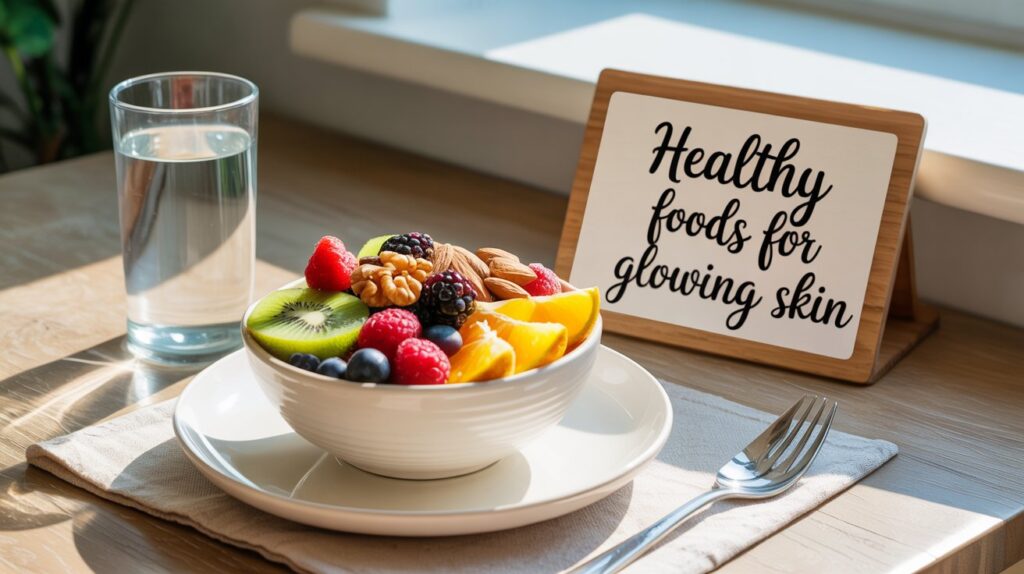
How to Build a Smart Routine (AM/PM)
AM routine
- Gentle cleanse (optional).
- Antioxidant step: apply a green tea serum or a freshly mixed vitamin C powder booster (low pH; avoid if very sensitive).
- Moisturizer: choose barrier-supportive formulas (oat/ceramides).
- Broad-spectrum SPF 30+ every day—antioxidants add protection but never replace sunscreen.
PM routine
- Cleanse.
- Targeted treatment (2–4×/wk):
- Colloidal oatmeal soak or mask for sensitivity/eczema.
- Kaolin or rice bran polishing paste for oil/texture.
- Turmeric mask (low concentration to reduce staining) for tone and calm. Wiley Online Library
- Serum (optional): niacinamide, hyaluronic acid.
- Moisturize to seal hydration.
Inside-out add-on: Collagen peptide powder (daily) for 8–12 weeks to complement topical care.
Safety & Best Practices
- Patch test new powders on the inner forearm for 24–48 hours.
- Mix powders with clean tools; avoid contamination.
- Don’t over-exfoliate with grainy mixes; rice bran should feel silky, not scratchy.
- Avoid fully drying clay masks; remove when slightly damp to protect barrier.
- Vitamin C: low pH can sting; start twice weekly and increase as tolerated.
- Turmeric can stain skin/fabrics; use sparingly and consider encapsulated formulas for better stability and less mess. Wiley Online Library
- For chronic skin conditions (e.g., eczema, melasma, severe acne), powders can complement—not replace—medical care.
Frequently Asked Questions
Q1) Are natural powders really “cleaner” or safer?
Not automatically. “Natural” describes the source, not the safety profile. Choose minimally processed, reputable brands and patch test. Wikipedia-level overviews help with definitions, but rely on peer-reviewed papers for efficacy.
Q2) Can powders replace my sunscreen?
No. Antioxidant powders like green tea and vitamin C can augment UV defense but are not UV filters. Keep your SPF habit daily.
Q3) Which powder should I start with for sensitive, itchy skin?
Begin with colloidal oatmeal soaks or masks—an evidence-backed choice for barrier support and itch relief in dermatitis.
Q4) Do collagen powders really work?
Expect modest, measurable improvements in elasticity and hydration after 8–12 weeks per RCTs and meta-analyses; results vary by dose and product.

Example Recipes (Simple & Safe)
- Calming Oat Milk Compress (Sensitive/Eczema-Prone)
1 tsp colloidal oatmeal + 50 mL cool water; saturate cotton and press on areas 5–10 minutes; follow with bland moisturizer. - Oil-Balancing Clay-Tea Mask (Oily/Combo)
1 tsp kaolin + 1 tsp brewed, cooled green tea; apply thinly 5–7 minutes; rinse before fully dry; moisturize. - Brightening Vitamin C Booster (Experienced Users)
Dissolve a pinch of ascorbic acid powder in a few drops of distilled water; pat on clean skin; follow with moisturizer and SPF next morning. (If stinging, dilute or switch to a derivative.) - Turmeric Glow Dab (Spot Care)
⅛ tsp turmeric + 1 tsp plain yogurt; dab for 5 minutes; rinse well to reduce staining; night-time only at first. Wiley Online Library
Popular Resources & Further Reading
- Colloidal Oatmeal for Skin—clinical improvements in dermatitis and itch with avenanthramides and β-glucans.
- Green Tea Catechins & Photoprotection—human evidence for reduced UV-induced changes; adjunct to sunscreen.
- Turmeric/Curcumin in Dermatology—systematic reviews and updates on mechanisms and clinical dermatology applications. Wiley Online LibraryLippincott
- Rice Bran & Oryzanol—antioxidant profile and traditional cosmetic use with modern analyses.
- Kaolin—cosmetic clay properties and uses.
- Vitamin C (Ascorbic Acid)—topical mechanisms, stability, and cosmetic dermatology insights.
- Oral Collagen Peptides—2021 systematic review/meta-analysis on skin aging outcomes.
Conclusion
Natural and healthy powders are more than DIY trends—they’re multifunctional actives backed by traditional use and a growing body of dermatologic research. If your goals include soothing sensitive skin, boosting antioxidant defenses, balancing oil, or brightening tone, there’s likely a powdered ally for the job: colloidal oatmeal for comfort, green tea and vitamin C for protection and radiance, kaolin and rice bran for clarity and texture, and collagen peptides to support the skin from within. Start simple, patch test, and build a routine that pairs these powders with daily SPF, smart moisturizers, and healthy habits. Done right, your skin can look calm, bright, and resilient—naturally.
References (Selected)
- Fowler JF Jr., et al. “Colloidal Oatmeal: History, Chemistry, and Clinical Properties.” J Drugs Dermatol (overview of mechanisms and clinical utility).
- Chiu AE, et al. “Photoprotective effects of green tea polyphenols in humans.” (human-data reviews and trials).
- Vaughn AR, et al. “Effects of Turmeric (Curcuma longa) on Skin Health.” Phytother Res 2016 (systematic review). Wiley Online Library
- Thawabteh AM, et al. “Skin Pigmentation—Types, Causes and Treatment.” Molecules 2023 (botanical lightening mechanisms incl. curcumin). MDPI
- “Kaolin.” Wikipedia (mineral properties & cosmetic applications).
- “Rice bran.” Wikipedia (composition incl. γ-oryzanol/ferulic acid).
- “Ascorbic acid.” Wikipedia / JCAD review on topical vitamin C (stability, mechanisms).
- De Miranda RB, et al. “Effects of Hydrolyzed Collagen Supplementation on Skin Aging…” Int J Dermatol 2021 (systematic review/meta-analysis).

